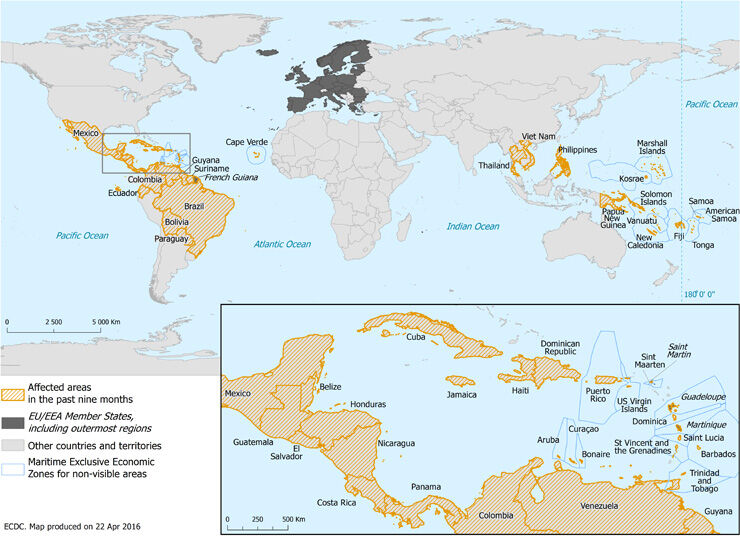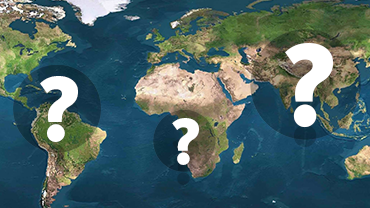Epidemiological update: Outbreaks of Zika virus and complications potentially linked to the Zika virus infection, 21 April 2016
On 16 April 2016, Peruvian health authorities reported the first local case of Zika virus infection through sexual transmission.
New developments since the last epidemiological update published on 15 April 2016
On 16 April 2016, Peruvian health authorities reported the first local case of Zika virus infection through sexual transmission. The Netherlands report continuing circulation of Zika virus in four (Curaçao, Aruba, Sint Maarten and Bonaire) of six islands constituting the Netherlands Outermost Territories in the Caribbean sea. In Chile, media quoting health authorities, report the presence of the Aedes aegypti mosquito (a competent vector for Zika) in Arica (2 000 kilometres north of Santiago).
Table 1. Countries and territories with reported confirmed autochthonous cases of Zika virus infection in the past two months, as of 22 April 2016
| Country/Territory | Current Zika transmission | Zika transmission in the past nine months |
|---|---|---|
| American Samoa | Increasing or widespread transmission | Yes |
| Aruba | Increasing or widespread transmission | Yes |
| Barbados | Increasing or widespread transmission | Yes |
| Belize | Sporadic transmission | Yes |
| Bolivia | Increasing or widespread transmission | Yes |
| Brazil | Increasing or widespread transmission | Yes |
| Bonaire | Sporadic transmission | Yes |
| Cape Verde | Increasing or widespread transmission | Yes |
| Colombia | Increasing or widespread transmission | Yes |
| Cuba | Sporadic transmission | Yes |
| Costa Rica | Increasing or widespread transmission | Yes |
| Curaçao | Increasing or widespread transmission | Yes |
| Dominica | Sporadic transmission | Yes |
| Dominican Republic | Increasing or widespread transmission | Yes |
| Ecuador | Increasing or widespread transmission | Yes |
| El Salvador | Increasing or widespread transmission | Yes |
| Fiji | Increasing or widespread transmission | Yes |
| French Guiana | Increasing or widespread transmission | Yes |
| Guadeloupe | Increasing or widespread transmission | Yes |
| Guatemala | Increasing or widespread transmission | Yes |
| Guyana | Increasing or widespread transmission | Yes |
| Haiti | Increasing or widespread transmission | Yes |
| Honduras | Increasing or widespread transmission | Yes |
| Jamaica | Sporadic transmission | Yes |
| Kosrae | Sporadic transmission | Yes |
| Marshall Islands | Increasing or widespread transmission | Yes |
| Martinique | Increasing or widespread transmission | Yes |
| Mexico | Increasing or widespread transmission | Yes |
| New Caledonia | Sporadic transmission | Yes |
| Nicaragua | Increasing or widespread transmission | Yes |
| Panama | Increasing or widespread transmission | Yes |
| Papua New Guinea | Sporadic transmission | Yes |
| Paraguay | No | Yes |
| Philippines | Sporadic transmission | Yes |
| Puerto Rico | Increasing or widespread transmission | Yes |
| Saint Lucia | Sporadic transmission | Yes |
| Saint Martin | Increasing or widespread transmission | Yes |
| Saint Vincent and the Grenadines | Sporadic transmission | Yes |
| Samoa | Increasing or widespread transmission | Yes |
| Sint Maarten | Sporadic transmission | Yes |
| Solomon Islands | No | Yes |
| Suriname | Increasing or widespread transmission | Yes |
| Thailand | No | Yes |
| Tonga | Increasing or widespread transmission | Yes |
| Trinidad and Tobago | Increasing or widespread transmission | Yes |
| Vanuatu | No | Yes |
| Venezuela | Increasing or widespread transmission | Yes |
| Vietnam | Increasing or widespread transmission | Yes |
| US Virgin Islands | Increasing or widespread transmission | Yes |
The classification of countries above is based on: 1) number of reported autochthonous confirmed cases; 2) number of affected areas in the country; 3) duration of the circulation.
EU/EEA and EU Outermost Regions and Territories
As of 21 April, no autochthonous vector-borne Zika virus transmission has been reported in the continental EU. ECDC is collecting data regarding imported cases through the media and official government communication lines. ECDC has recorded 414 imported cases in 17 EU/EEA countries. Twenty-four of the imported cases are pregnant women. In addition, one confirmed case was published following the diagnosis in a Slovenian hospital. The number of imported cases reported is not based on a systematic reporting surveillance systems hence cannot be considered exhaustive.
EU’s Outermost Regions and Territories:
- The Netherlands report continuing circulation of Zika virus in four (Curaçao, Aruba, Sint Maarten and Bonaire) of six islands constituting the Netherlands Outermost Territories in the Caribbean sea.
Figure 1. Countries or territories with reported confirmed autochthonous cases of Zika virus infection in the past two months, as of 22 April 2016

Figure 2. Countries and territories with reported confirmed autochthonous cases of Zika virus infection in the past nine months, as of 22 April 2016

Update on the observed increase of congenital Zika syndrome and other neurological complications
Microcephaly and other foetal malformations potentially associated with Zika virus infection or suggestive of congenital infection have been reported in Brazil (1 168 cases), Cape Verde (two cases), Colombia (seven cases), French Polynesia (eight cases), Martinique (three cases) and Panama (three cases). In the Marshall Islands, the health authorities report a case of microcephaly in the baby of a mother who was IgM Zika positive that occurred in March 2016.
In the context of Zika virus circulation, 13 countries or territories have reported an increased incidence of Guillain-Barré syndrome (GBS) and/or laboratory confirmation of a Zika virus infection among GBS cases.
Brazil
Between October 2015 and as of 9 April 2016, Brazil reported 7 150 suspected cases of microcephaly from 1 348 municipalities in all states and in the Federal District. Of these cases, 1 168 are reported as confirmed cases of microcephaly with 192 having laboratory confirmation of Zika virus infection. Of the remaining cases, 2 241 were investigated and discarded as they did not fit the case definition, while 3 741 cases are still under investigation.
Among the 7 150 suspected cases of microcephaly, 240 intrauterine or neonatal deaths were reported. Of these, 51 cases were investigated and confirmed (microcephaly and/or central nervous system malformations).
Colombia
Since the beginning of 2016, 33 microcephaly cases have been detected in Colombia, which is not unexpected. Of these, 30 are under investigation for Zika virus and three have been discarded. Since December 2015 and as of epidemiological week 13 2016, 416 cases of neurological syndromes including GBS have been associated with Zika virus infection.
Congenital zika syndrome and GBS
As of 20 April 2016, microcephaly and other foetal malformations potentially associated with Zika virus infection or suggestive of congenital infection have been reported in seven countries (Brazil, Cape Verde, Colombia, French Polynesia, Martinique, Marshall Islands and Panama). Two additional cases, each linked to a stay in Brazil, were detected in Slovenia and the United States of America. One more case was reported in a returning traveller from the affected countries in the United States of America. In the context of Zika virus circulation, 13 countries and territories worldwide have reported an increased incidence of Guillain-Barré syndrome (GBS) and/or laboratory confirmation of a Zika virus infection among GBS cases.





